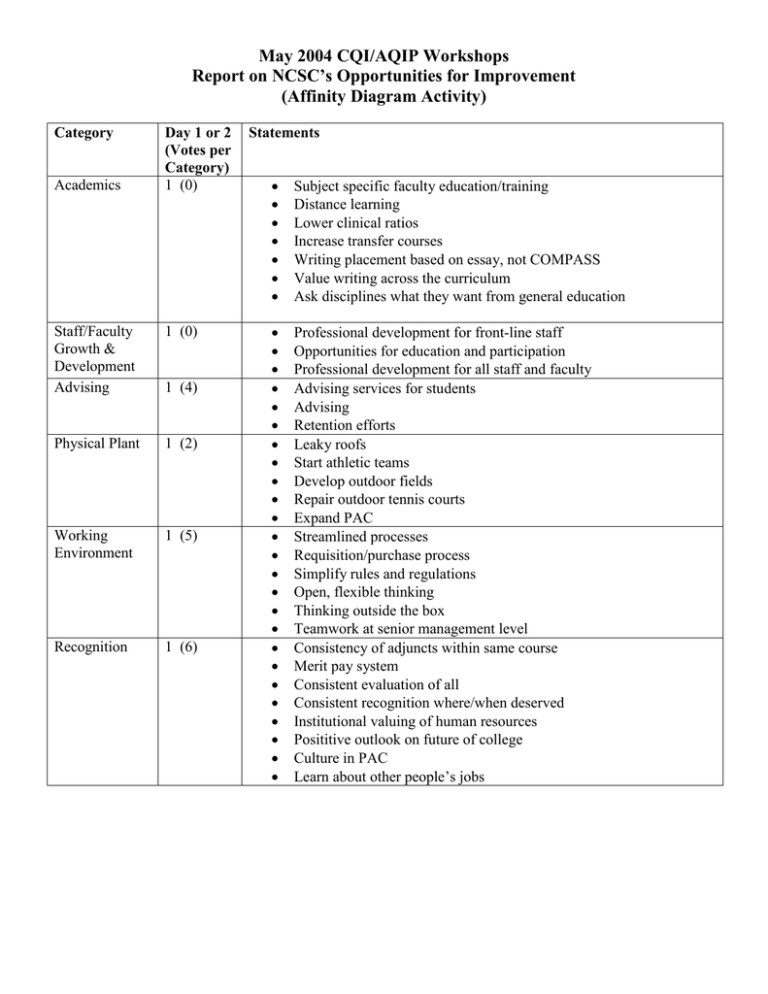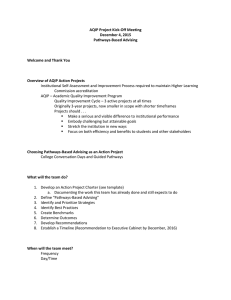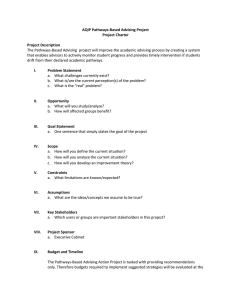Opportunities for improvement
advertisement

May 2004 CQI/AQIP Workshops Report on NCSC’s Opportunities for Improvement (Affinity Diagram Activity) Category Academics Day 1 or 2 (Votes per Category) 1 (0) Staff/Faculty Growth & Development Advising 1 (0) Physical Plant 1 (2) Working Environment 1 (5) Recognition 1 (6) 1 (4) Statements Subject specific faculty education/training Distance learning Lower clinical ratios Increase transfer courses Writing placement based on essay, not COMPASS Value writing across the curriculum Ask disciplines what they want from general education Professional development for front-line staff Opportunities for education and participation Professional development for all staff and faculty Advising services for students Advising Retention efforts Leaky roofs Start athletic teams Develop outdoor fields Repair outdoor tennis courts Expand PAC Streamlined processes Requisition/purchase process Simplify rules and regulations Open, flexible thinking Thinking outside the box Teamwork at senior management level Consistency of adjuncts within same course Merit pay system Consistent evaluation of all Consistent recognition where/when deserved Institutional valuing of human resources Posititive outlook on future of college Culture in PAC Learn about other people’s jobs Communication 1 (10) 2 (10) Orientation 1 (1) 2 (2) Vision and Strategic Plan 1 (8) Campus-wide communication (x2) Communication (x3) Dialogue/interaction President’s office and college faculty and staff Financial aid opportunities for students Empower others in decision-making process Shared governance Freedom of speech, top-down and down-up communication Communication processes, senders and receivers Keep people up to date on changes Communication within the organization, vertical and horizontal Change Curriculum Committee from “star chamber” to helpful/encouraging forum, recognizes faculty as subject matter experts Communication, all directions Communication Listening Interdepartmental communication Celebrate individual and institutional achievements Communication, internal and external New employee orientation plan Orientate all, S, F & A Introduction of new employees to college New employee orientation to culture of college Health benefits fair for all faculty/staff Mentoring of adjunct New “person” orientation New employee orientation (x2) New employee (faculty) orientation, training Integrated orientation process Planning Viable institutional vision and planning process A real, collective vision of who we are and who we want to be Accurate collection of data Regular planning sessions at all levels 2 (8) Empowerment and Trust 1 (10) Mission, vision, goals – revisit, revise, ownership Develop means to acquire up to date instructional tools Improving mission/vision, changing it to match what we actually do Shared vision Assessment processes related to strategic plan/institutional goals, connected and accessible Bottom up planning Strategic planning – linkages to institutional/departmental goals Strategic planning (x2) Board of Trustees Administrative Cabinet Faculty/Staff Senate Exploration, acknowledgement, spirit, teamwork, friendliness, levity, “can do,” camaraderie, free thinking Technology support, new computers Holistic ideas More autonomy Give authority, not just responsibility Freedom to make improvements/restructure as teams see fit Ownership to individuals Trust people to make decisions Empowered employees Keep “entire” college community in mind at all times Mutual respect within all departments Lose past baggage Stop complaining about the past More respect of others and their jobs Let go of the past Leaders that trust and empower employees Give experts authority to do what they can do Be “naïve” again, not closed minded Actively manage policy and procedure system Hold those responsible accountable Trust Value new-innovative ideas Build trust throughout college community 2 (9) Empowerment of supervisors for decision making Power to change procedures and processes to those who do them Use strengths of people in the college Support of lower level initiatives Staff empowerment Company involvement Community improvement – serve more students, tell our public message better Assessment within staff and administrative areas, perhaps with 360 degree evaluation Management seeks input of all employees through regular small group meetings Advertising/communication about specific programs Encourage creativity Access to institutional data, reports Evaluation process/tool Evaluation process Ongoing professional development Faculty evaluation system Higher enrollment standards Safety processes re: tornados, etc. Faculty advising Student knowledge of procedures Policy for late registrations and withdrawals Student intake procedures Student orientation process Admissions process Student admission (recruitment to first visit to enrollment) Safety on campus – emergency phones in parking lots Tutoring, student tutors in technical courses Support for on-line course expansion Financial policies and procedures Compensation for adjunct instructors Inservices/training meetings for staff Realign pay scale – more equitable with job person is doing Wages competitive with workforce Evaluation Methods 2 (0) Student Success 2 (9) Financial Policies and Procedures 2 (2)

